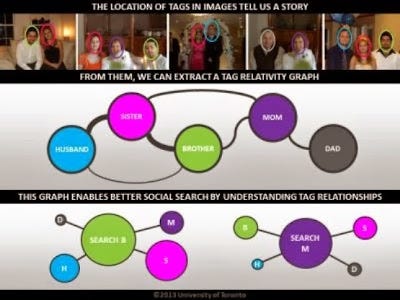New search tool will allow anyone to find you even in untagged photos

A new algorithm designed at the University of Toronto has the power to profoundly change the way we find photos among the billions on social media sites such as Facebook and Flickr. This month, the United States Patent and Trademark Office will issue a patent on this technology.
Developed by Parham Aarabi, a professor in The Edward S. Rogers Sr. Department of Electrical & Computer Engineering, and his former Master’s student Ron Appel, the search tool uses tag locations to quantify relationships between individuals, even those not tagged in any given photo.
Imagine you and your mother are pictured together, building a sandcastle at the beach. You’re both tagged in the photo quite close together. In the next photo, you and your father are eating watermelon. You’re both tagged. Because of your close ‘tagging’ relationship with both your mother in the first picture and your father in the second, the algorithm can determine that a relationship exists between those two and quantify how strong it may be.
In a third photo, you fly a kite with both parents, but only your mother is tagged. Given the strength of your ‘tagging’ relationship with your parents, when you search for photos of your father the algorithm can return the untagged photo because of the very high likelihood he’s pictured.
“Two things are happening: we understand relationships, and we can search images better,” says Professor Aarabi.
The nimble algorithm, called relational social image search, achieves high reliability without using computationally intensive object- or facial-recognition software.
“If you want to search a trillion photos, normally that takes at least a trillion operations. It’s based on the number of photos you have,” says Aarabi. “Facebook has almost half a trillion photos, but a billion users—it’s almost a 500 order of magnitude difference. Our algorithm is simply based on the number of tags, not on the number of photos, which makes it more efficient to search than standard approaches.”
http://media.utoronto.ca/media-releases/new-algorithm-finds-you-even-in-untagged-photos-2/
DOJ funds 'pre-crime' and facial recognition research for state and local police:
The federal government spends considerable sums every year funding the research, development, and procurement of advanced surveillance technologies. Often these funds are given to private companies that have a long-term financial interest in the development of cutting edge surveillance products. Luckily for them, they can get government assistance to develop these tools, and then profit off of selling the finished product back to government agencies. The Departments of Defense, Homeland Security, and Justice each have their own research and development programs for surveillance tools of all kinds, and state and local police departments nationwide benefit from the trickle down of technology and gear.
One of the federal offices that funds substantial R&D in surveillance technology is the Office of Justice Programs' National Institute of Justice (NIJ). The NIJ describes itself as the "research, development and evaluation agency of the U.S. Department of Justice — [] dedicated to improving knowledge and understanding of crime and justice issues through science. NIJ provides objective and independent knowledge and tools to reduce crime and promote justice, particularly at the state and local levels," its website says. The research monies invested at NIJ have a substantial effect on the tools, methodologies, and training systems deployed by police departments throughout the country, now and in the future. The agency's funding choices therefore have a real impact on hundreds of millions of people's lives. The NIJ is putting lots of its R&D money towards investigating the efficacy of 'predictive policing', sometimes known as 'intelligence-led policing'. Others simply call it 'pre-crime'. Predictive policing uses big data, behavioral and associational surveillance models, and computer algorithms to direct public safety resources and focus patrols. Among the 2013 NIJ-funded grant awards related to pre-crime are:
$245k to Carnegie Mellon University "to develop an adaptive expert system that searches internet escort advertisements to determine which ads are associated with sex trafficking";
$553k to George Mason University to study the efficacy of using automatic license plate readers to track motorists in targeted areas;
$760k to the University of Chicago to work with the NYPD to determine "behavioral interventions" for "improving hot-spot policing";
$499k to Justice & Security Strategies, Inc. to test geospatial predictive policing strategies at the Columbia, SC police department;
$383k to the NYPD for a "proposed multi-level analysis of the effectiveness of Risk Terrain Modeling for allocating police resources", a fancy way of saying predictive policing by neighborhood; and
$28k to Washington State University to test a geospatial predictive policing theory related to "natural surveillance" and residential burglaries.
Among the other NIJ grant awards for 2013 are:
$490k to Unmanned Experts, LLC to use small drones to capture depth-of-field images of car crashes so that law enforcement can accurately reconstruct them after the fact;
$493k to Carnegie Mellon University to "develop a software tool that can be disseminated to law enforcement and other criminal justice agencies that will provide them with the capability to perform facial recognition using low quality, low resolution images, such as those obtained from CCTV surveillance footage";
$1.6 million to the RAND Corporation to identify high priority technologies for law enforcement, corrections, and courts;
$119k to Michigan State University to develop technology that would match police sketches of suspects to images in government databases, using biometric face recognition software; and
$474k to General Electric to develop video analytics technologies including low-light, low-resolution face recognition tied to CCTV systems.
The government and private corporations are racing ahead to build the next big thing in domestic surveillance for police departments and federal law enforcement at all levels.


